1. DSM-048 2.4GHz Wi-Fi Module Introduction
DSM-048 is a low-power-consuming embedded 2.4GHz Spread-Spectrum module. It consists of the highly integrated wireless radio processor chip, EFR32MG21A020F768IM32-B, and several peripherals, with a wireless protocol stack and robust library functions.
DSM-048 is a FreeRTOS platform integrating the function library of all the related protocols. The User can develop embedded wireless products that meet their needs based on these function libraries.
- Built-in low power-consumption 32-bit Cortex-M33 core with DSP instructions and floating-point unit function as an application processor
- Clock rate: 80MHz
- Peripherals: 9XGPIOs, 1XUART, 1XADC
- Working voltage: 2.0 V to 3.8 V
- Wireless RF Connectivity
802.15.4 MAC/PHY supported
Working channel: 11 to 26 @2.400 GHz to 2.483 GHz, with an air interface, rate of 250 Kbps
Maximum output power: +10 dBm; dynamic difference of output power: > 35 dB
Power consumption when DSM-048 is working: 60 μA/MHz; current when DSM-048 is in sleep mode: 5.0 μA
AES 128/256-based hardware encryption
The terminal device actively enters into the pairing mode - Dimension: 17 x 22 x 2.8 mm
- Working temperature: –40°C to +85°C
- Certification CE, FCC, SRRC
- Intelligent Building
- Intelligent Home And Household Applications
- Industrial Wireless Control
- Intelligent Public Traffic
- Intelligent socket and smart lighting
- Web Camera
- Baby Monitor
2. Mechanical Requirement of DSM-048 2.4GHz Wi-Fi Module
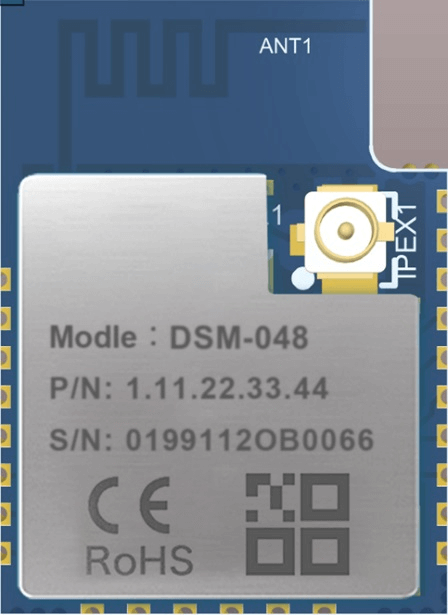
DSM-048 provides thress lines of pins with a distance of 1.27±0.1mm between every two pins.
Dimensions: 14.9±0.35 mm (W) x20 ±0.35 mm (L) x 2.8±0.15 mm (H).
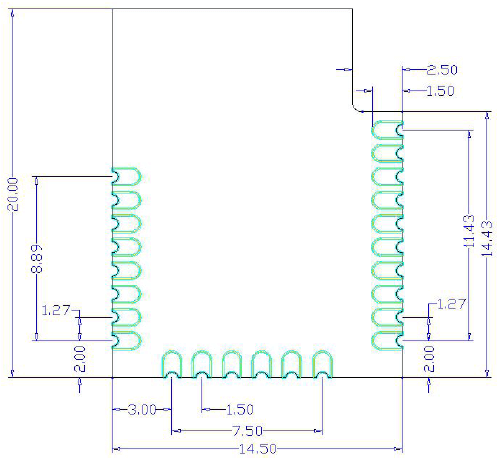
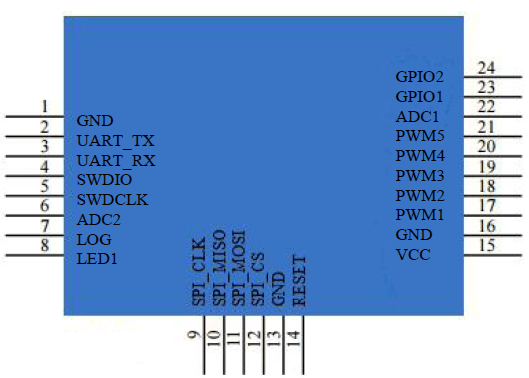
| Pin Number | Symbol | IO Type | Function |
|---|---|---|---|
| 1 | GND | P | Power supply reference ground pin |
| 2 | UART_TX | PA05 | MP test points need to be reserved for calibration |
| 3 | UART_RX | PA06 | MP test points need to be reserved for calibration |
| 4 | SWDIO | PA02 | GPIO interface; 8mA drive capability. Wake-up function. Internal strong/weak pull-up and pull-down. SWDIO (default) |
| 5 | SWDCLK | PA01 | |
| 6 | ADC2 | PB02 | GPIO interface, which can be configured as an ADC |
| 7 | LOG | PB01 | Power-on mode: normal operation pull-down, bypassing the program code executed in the flash (the PAD internal pull-down by default). |
| 8 | LED1 | PB00 | Common GPIO interface |
| 9 | SPI_CLK | PC02 | Common GPIO interface |
| 10 | SPI_MISO | PC01 | Common GPIO interface |
| 11 | SPI_MOSI | PC00 | Common GPIO interface |
| 12 | SPI_CSN | PC03 | Common GPIO interface |
| 13 | GND | GND | Power supply reference ground pin |
| 14 | RESET | RESET | MP test points need to be reserved for calibration |
| 15 | VCC | VCC | 1. Power:2V ~ 3.6V 2. MP test points need to be reserved for calibration |
| 16 | GND | P | Power supply reference ground pin |
| 17 | PWM1 | PD04 | Support PWM function LED (fixed timer), default connection cold LED |
| 18 | PWM2 | PD03 | Support PWM function LED (fixed timer), default connection warm LED |
| 19 | PWM3 | PD02 | 1. The I2C SDA 2. LED support PWM such as breathing light (adjustable timer) 3. Red LED by default |
| 20 | PWM4 | PC04 | 1. The I2C SCL 2. LED support PWM such as breathing light (adjustable timer) 3. Green LED by default |
| 21 | PWM5 | PC05 | 1. LED support PWM such as breathing light (adjustable timer) 2. Blue LED by default |
| 22 | ADC1 | PD00 | Common GPIO interface |
| 23 | GPIO1 | PA03 | Common GPIO interface |
| 24 | GPIO2 | PA04 | Common GPIO interface |
•P indicates power supply pins, I/O indicates input/output pins
3. Electrical parameters of DSM-048 2.4GHz Wi-Fi Module
| Parameter | Description | Typical value |
Minimum value | Maximum value | Unit |
|---|---|---|---|---|---|
| Ts | Storage temperature | -50 | 150 | ℃ | |
| VCC | Power supply voltage | 2.0 | 3.8 | V | |
| Static electricity voltage (human body model) | TAMB-25℃ | - | 2 | KV | |
| Static electricity voltage (machine model) | TAMB-25℃ | - | 0.5 | KV |
| Parameter | Description | Minimum value | Maximum value | Typical Value |
Unit |
|---|---|---|---|---|---|
| Ta | Working temperature | -40 | 105 | - | ℃ |
| VCC | Power supply voltage | 2.0 | 3.8 | 3.0 | V |
| VIL | I/O low-level input | - | I0VDD*0.3 | V | |
| VIH | I/O high-level input | I0VDD*0.7 | - | - | V |
| VOL | I/O low-level output | - | I0VDD*0.2 | - | V |
| VOH | I/O high-level output | I0VDD*0.8 | - | - | V |
NOTE: VCC=3.0V, Tamb=-10~70℃
| Working status | Rate | TX Power/ Receiving | Typical value | Average value |
Unit |
|---|---|---|---|---|---|
| TX | 250 Kbps | +10dBm | 64 | 62 | mA |
| TX | 250 Kbps | 0dBm | 25 | 20 | mA |
| RX | 125 Kbps | Constant receiving | 12 | 10 | mA |
| RX | 500 Kbps | Constant receiving | 12 | 10.5 | mA |
| RX | 1Mbps | Constant receiving | 11 | 9 | mA |
| RX | 2Mbps | Constant receiving | 12 | 10 | mA |
| RX | 250 Kbps | Constant receiving | 12.5 | 11 | mA |
| Working status | Operating condition, Ta=25℃ | Typical value | Average value |
Unit |
|---|---|---|---|---|
| Quick configuration | Module in the quick configuration state | 40 | 10 | mA |
| Network connection state | Connected to a network | 5 | 4.2 | mA |
| Deep sleep mode | Deep-sleep mode and retains 64KB RAM | - | 5 | uA |
4. RF features of DSM-048 2.4GHz Wi-Fi Module
| Parameter | Description |
|---|---|
| Frequency band | 2.412~2.483.5GHz |
| Data transmission rate | 250 Kbps |
| Antenna type | PCB antenna with gain 1dBi, ipex (optional) |
| Parameter | Minimum value | Typical value | Maximum value | Unit |
|---|---|---|---|---|
| Maximum output power | - | 10 | - | dBm |
| Minimum output power | - | -30 | - | dBm |
| Output power adjustment step | - | 0.5 | 1 | dBm |
| Output spectrum adjacent-channel rejection ratio | -31 | dBc | ||
| Frequency error | -15 | - | 15 | ppm |
| Parameter | Minimum value | Typical value | Maximum value | Unit |
|---|---|---|---|---|
| PER<1%, RX sensitivity(250Kbps) | -103 | -102 | -100 | dBm |
5. Antenna of DSM-048 2.4GHz Wi-Fi Module
This product uses an onboard PCB antenna.
To ensure optimal RF performance, it is recommended that the antenna be at least 15 mm away from other metal parts. If metal materials are wrapped around the antenna, the wireless signals will be reduced greatly, deteriorating the RF performance.
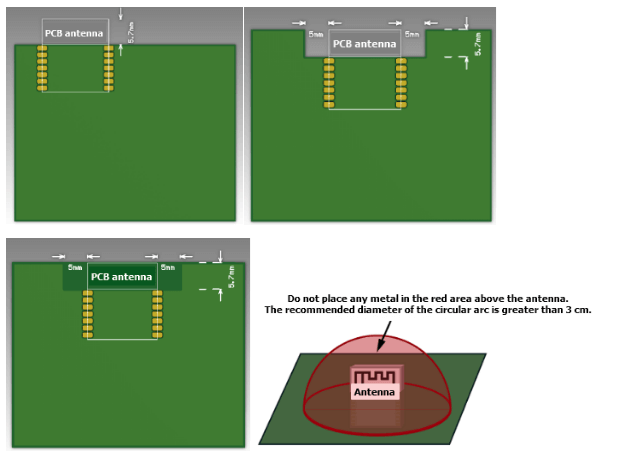
6. Firmware of DSM-048 2.4GHz Wi-Fi Module
We offer customized product solutions, including temperature/door/window/PIR/leakage sensors, smart meter, smart lock, etc., and provide related API documents and support. Customers can pair the device to the gateway (Dusun gateway or Private gateway )according to the API description and standard Zigbee 3.0 protocol.
API document includes reading sensor data, controlling device switches, setting configuration of the device, OTA, etc.
There is currently support for custom Zigbee devices and providing the complete solution based on the Dusun Gateway, which can connect to the customer web platform via MQTT protocol. So Customers can easily deploy the entire system and view status and real-time data from end devices.
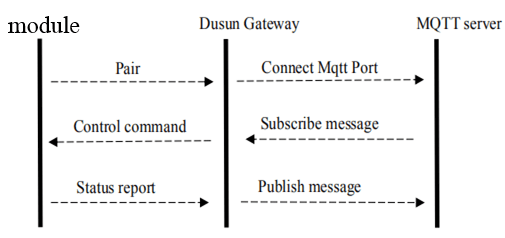
| Product Name | Wireless Device | Firmware Name |
|---|---|---|
| DSM-048-1 | Temperature &humidity sensor | DSM-048_T&H sensor.bin |
| DSM-048-2 | Door/window sensor | DSM-048_Door.bin |
| DSM-048-3 | PIR | DSM-048_PIR.bin |
| DSM-048-4 | Leakage | DSM-048_Leakage.bin |
| DSM-048-5 | Plug | DSM-048-Plug.bin |
| DSM-048-6 | Light Switch/Dimmer Switch | DSM-048-Switch.bin |
| DSM-048-7 | Smoke | DSM-048-Smoke.bin |
| DSM-048-8 | Emergency button | DSM-048-SOS button.bin |
| DSM-048-9 | RGB lighting | DSM-048-RGB.bin |
| DSM-048-10 | Thermostat | DSM-048-thermostat.bin |
7. Production instructions of DSM-048 2.4GHz Wi-Fi Module
1). Use an SMT placement machine to mount components to the stamp hole module that DUSUN produces within 24 hours after the module is unpacked and the firmware is burned. If not, vacuum packs the module again. Bake the module before mounting components to the module.
- SMT placement equipment:
Reflow soldering machine
Automated optical inspection (AOI) equipment
Nozzle with a 6 mm to 8 mm diameter - Baking equipment:
Cabinet oven
Anti-static heat-resistant trays
Anti-static heat-resistant gloves
2). Storage conditions for a delivered module are as follows:
- The moisture-proof bag is placed in an environment where the temperature is below 30℃ and the relative humidity is lower than 70%.
- The shelf life of a dry-packaged product is six months from the date when the product is packaged and sealed.
- The package contains a humidity indicator card (HIC).

3). Bake a module based on HIC status as follows when you unpack the module package:
- If the 30%, 40%, and 50% circles are blue, bake the module for 2 consecutive hours.
- If the 30% circle is pink, bake the module for 4 consecutive hours.
- If the 30% and 40% circles are pink, bake the module for 6 consecutive hours.
- If the 30%, 40%, and 50% circles are pink, bake the module for 12 consecutive hours.
4). Baking settings:
- Baking temperature: 125±5℃
- Alarm temperature: 130℃
- SMT placement ready temperature after natural cooling: < 36℃
- Number of drying times: 1
- Rebaking condition: The module is not soldered within 12 hours after baking.
5). Do not use SMT to process modules that have been unpacked for over three months.
Electroless nickel immersion gold (ENIG) is used for the PCBs. If the solder pads are exposed to the air for over three months, they will be oxidized severely and dry joints or solder skips may occur. Roombanker is not liable for such problems and consequences.
6). Before SMT placement, take electrostatic discharge (ESD) protective measures.
7). To reduce the reflow defect rate, draw 10% of the products for visual inspection and AOI before first SMT placement to determine a proper oven temperature and component placement method. Draw 5 to 10 modules every hour from subsequent batches for visual inspection and AOI.
Perform SMT placement based on the following reflow oven temperature curve. The highest temperature is 245℃.
Based on the IPC/JEDEC standard, perform reflow soldering on a module at most twice.
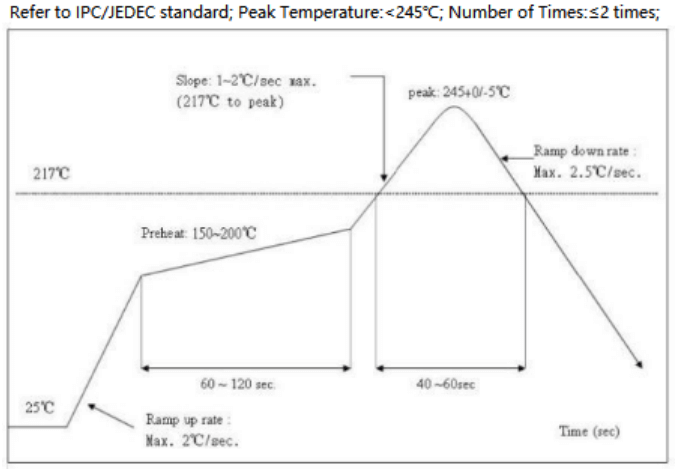
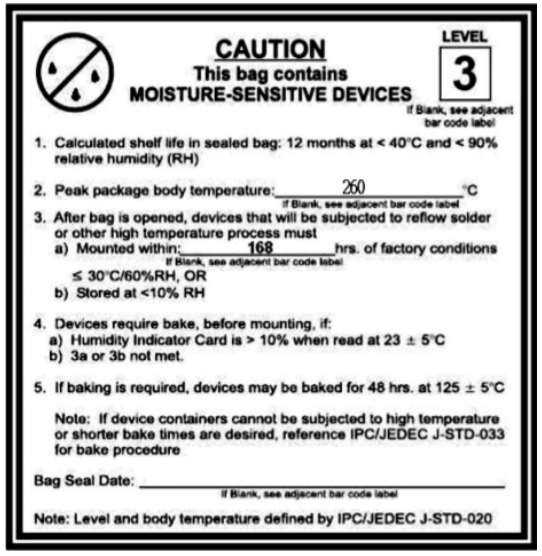
8. MOQ and packing
| Product model | MOQ(pcs) | Packing method | Number of Modules in each reel pack | Number of reel packs in each box |
|---|---|---|---|---|
| DSM-048 | 4000 | Carrier tape and reel packing | 1000 | 4 |


















